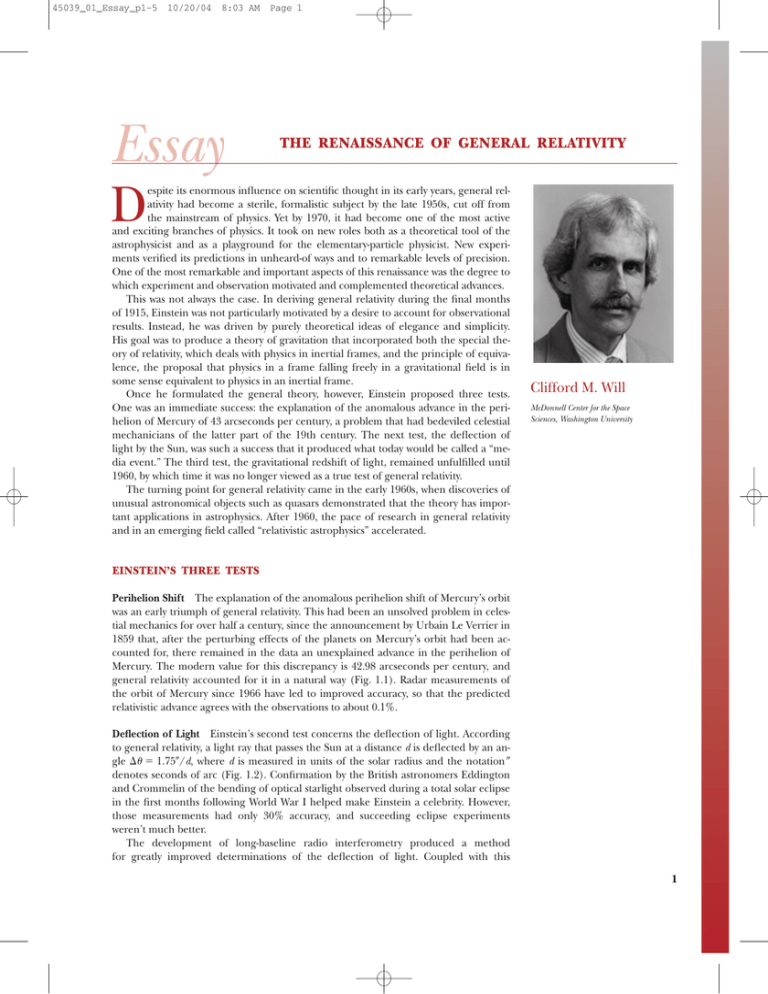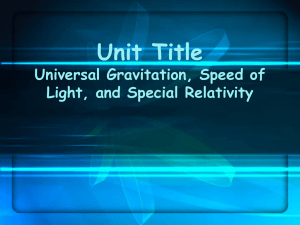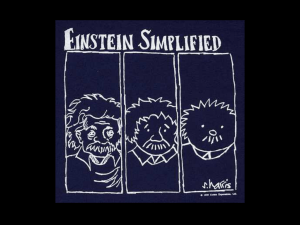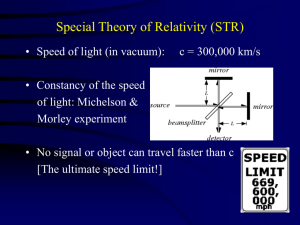Essay D THE RENAISSANCE OF GENERAL RELATIVITY
advertisement

45039_01_Essay_p1-5 10/20/04 8:03 AM Essay Page 1 THE RENAISSANCE OF GENERAL RELATIVITY D espite its enormous influence on scientific thought in its early years, general relativity had become a sterile, formalistic subject by the late 1950s, cut off from the mainstream of physics. Yet by 1970, it had become one of the most active and exciting branches of physics. It took on new roles both as a theoretical tool of the astrophysicist and as a playground for the elementary-particle physicist. New experiments verified its predictions in unheard-of ways and to remarkable levels of precision. One of the most remarkable and important aspects of this renaissance was the degree to which experiment and observation motivated and complemented theoretical advances. This was not always the case. In deriving general relativity during the final months of 1915, Einstein was not particularly motivated by a desire to account for observational results. Instead, he was driven by purely theoretical ideas of elegance and simplicity. His goal was to produce a theory of gravitation that incorporated both the special theory of relativity, which deals with physics in inertial frames, and the principle of equivalence, the proposal that physics in a frame falling freely in a gravitational field is in some sense equivalent to physics in an inertial frame. Once he formulated the general theory, however, Einstein proposed three tests. One was an immediate success: the explanation of the anomalous advance in the perihelion of Mercury of 43 arcseconds per century, a problem that had bedeviled celestial mechanicians of the latter part of the 19th century. The next test, the deflection of light by the Sun, was such a success that it produced what today would be called a “media event.” The third test, the gravitational redshift of light, remained unfulfilled until 1960, by which time it was no longer viewed as a true test of general relativity. The turning point for general relativity came in the early 1960s, when discoveries of unusual astronomical objects such as quasars demonstrated that the theory has important applications in astrophysics. After 1960, the pace of research in general relativity and in an emerging field called “relativistic astrophysics” accelerated. Clifford M. Will McDonnell Center for the Space Sciences, Washington University EINSTEIN’S THREE TESTS Perihelion Shift The explanation of the anomalous perihelion shift of Mercury’s orbit was an early triumph of general relativity. This had been an unsolved problem in celestial mechanics for over half a century, since the announcement by Urbain Le Verrier in 1859 that, after the perturbing effects of the planets on Mercury’s orbit had been accounted for, there remained in the data an unexplained advance in the perihelion of Mercury. The modern value for this discrepancy is 42.98 arcseconds per century, and general relativity accounted for it in a natural way (Fig. 1.1). Radar measurements of the orbit of Mercury since 1966 have led to improved accuracy, so that the predicted relativistic advance agrees with the observations to about 0.1%. Deflection of Light Einstein’s second test concerns the deflection of light. According to general relativity, a light ray that passes the Sun at a distance d is deflected by an angle 1.75/d, where d is measured in units of the solar radius and the notation denotes seconds of arc (Fig. 1.2). Confirmation by the British astronomers Eddington and Crommelin of the bending of optical starlight observed during a total solar eclipse in the first months following World War I helped make Einstein a celebrity. However, those measurements had only 30% accuracy, and succeeding eclipse experiments weren’t much better. The development of long-baseline radio interferometry produced a method for greatly improved determinations of the deflection of light. Coupled with this 1 45039_01_Essay_p1-5 2 10/20/04 CHAPTER 1 8:03 AM Page 2 ESSAY Mercury Sun Star (real position) Orbit of Mercury Star (apparent position) Perihelion of Mercury Earth Sun Figure 1.1 (a) Advance of the perihelion of Mercury. The elliptical orbit of Mercury about the Sun rotates very slowly relative to the system connected with the Sun. General relativity successfully explains this small effect, which predicts that the direction of the perihelion should change by only 43 arcseconds per century. (b) The diagram shows how a two-dimensional surface warped into three dimensions can change the direction of a “straight” line that is constrained to its surface; the warping of space is analogous, although with a greater number of dimensions to consider. The effect is similar to a golfer putting on a warped green. Though the ball is hit in a straight line, we see it appear to curve. (From J. M. Pasachoff, Astronomy: From The Earth to the Universe, 4th ed., Philadelphia, Saunders College Publishing, 1991.) technological advance is a series of heavenly coincidences: Each year groups of strong quasars pass near the Sun (as seen from Earth). The idea is to measure the differential deflection of radio waves from one quasar relative to those from another as they pass near the Sun. A number of measurements of this kind occurred almost annually over the period from 1969 to 1975, yielding a confirmation of the predicted deflection to 1.5%. Recent measurements have improved this to 0.1%. Gravitational Redshift Another consequence of Einstein’s insight is the gravitational redshift effect, which is a frequency shift between two identical clocks placed at 45039_01_Essay_p1-5 10/20/04 8:03 AM Page 3 THE RENAISSANCE OF GENERAL RELATIVITY Apparent direction to star Deflected path of light from star 1.75" Sun To star (actual direction) Earth Figure 1.2 Deflection of starlight passing near the Sun. Because of this effect, the Sun and other remote objects can act as a gravitational lens. In his general relativity theory, Einstein calculated that starlight just grazing the Sun’s surface should be deflected by an angle of 1.75 . different heights in a gravitational field. For small differences in height h between clocks, the shift in the frequency f is given by f gh 2 f c where g is the local gravitational acceleration and c is the speed of light. If the receiver clock is at a lower height than the emitter clock, the received signal is shifted to higher frequencies (“blueshift”); if the receiver is higher, the signal is shifted to lower frequencies (“redshift”). The most precise gravitational redshift experiment performed to date was a rocket experiment carried out in June 1976. A “hydrogen maser” atomic clock was flown on a Scout D rocket to an altitude of 10,000 km and its frequency compared with a similar clock on the ground using radio signals. After the effects of the rocket’s motion were taken into account, the observations confirmed the gravitational redshift to 0.02%. APPLICATIONS General relativity has passed every experimental test to which it has been put, and many alternative theories have fallen by the wayside. Most physicists now take the theory for granted and look to see how it can be used as a practical tool in physics and astronomy. For example, gravitational redshift must now be taken into account properly in order for the Global Positioning System (GPS) to perform its navigation function accurately. Gravitational Radiation One of these new tools is gravitational radiation, a subject almost as old as general relativity. By 1916, Einstein had succeeded in showing that the field equations of general relativity admitted wavelike solutions analogous to those of electromagnetic theory. For example, a dumbbell rotating about an axis passing at right angles through its handle will emit gravitational waves that travel at the speed of light. They also carry energy away from the dumbbell, just as electromagnetic waves carry energy away from a light source. In 1968, Joseph Weber initiated a program of gravitational-wave detection using massive aluminum bars as detectors. A passing gravitational wave acts as an oscillating gravitational force field that alternately compresses and extends the bar lengthwise. Currently a dozen laboratories around the world are engaged in building and improving on the basic “Weber bar” detector, striving to reduce noise from thermal, electrical, and environmental sources in order to detect the very weak oscillations produced by a gravitational wave. For a bar of 1 meter length, the challenge is to detect a variation in 3 45039_01_Essay_p1-5 4 10/20/04 CHAPTER 1 8:03 AM Page 4 ESSAY length smaller than 1020 meters, or 105 of the radius of a proton. At the same time, several “laser-interferometric” gravitational-wave observatories are under construction or in operation in the United States and Europe. They are bouncing laser beams to monitor variations in length between mirrors spaced several kilometers apart. The observatories were scheduled to be operational around the year 2000. Black Holes The first glimmerings of the black hole idea date to the 18th century, in the writings of a British amateur astronomer, the Reverend John Michell. Reasoning on the basis of the corpuscular theory that light would be attracted by gravity, he noted that the speed of light emitted from the surface of a massive body would be reduced by the time the light was very far from the source. (Michell of course did not know special relativity.) It would therefore be possible for a body to be sufficiently massive and compact to prevent light from escaping from its surface. Although the general relativistic solution for a nonrotating black hole was discovered by Karl Schwarzschild in 1916, and a calculation of gravitational collapse to a black hole state was performed by J. Robert Oppenheimer and Hartland Snyder in 1939, black hole physics didn’t really begin until the middle 1960s, when astronomers confronted the problem of the energy output of the quasars and started to take black holes seriously. A black hole is formed when a star has exhausted the thermonuclear fuel necessary to produce the heat and pressure that support it against gravity. The star begins to collapse, and if it is massive enough, it continues to collapse until its radius approaches a value called the gravitational radius, or Schwarzschild radius. In the nonrotating spherical case, this radius is 2GM/c 2, where M is the mass of the star. For a body of one solar mass, the gravitational radius is about 3 km; for a body of the mass of the Earth, it is about 9 mm. An observer sitting on the surface of the star sees the collapse continue to smaller and smaller radii, until both star and observer reach the origin r 0, with consequences too horrible to describe. On the other hand, an observer at great distances observes the collapse to slow down as the radius approaches the gravitational radius, a result of the gravitational redshift of the light signals sent outward. The distant observer never sees any signals emitted by the falling observer once the latter is inside the gravitational radius. This is because any signal emitted inside can never escape the sphere bounded by the gravitational radius, called the “event horizon.” In 1974, Stephen Hawking discovered that the laws of quantum mechanics require a black hole to evaporate by the creation of particles with a thermal energy spectrum and to have an associated temperature and entropy. The temperature of a Schwarzschild black hole is T hc 3/8kBGM, where h is Planck’s constant and k B is Boltzmann’s constant. This discovery demonstrated a remarkable connection between gravity, thermodynamics, and quantum mechanics that helped renew the theoretical quest for a grand synthesis of all the fundamental interactions. On the other hand, for black holes of astronomical masses, the evaporation is completely negligible, because for a solar-mass black hole, T 106 K. Although a great deal is known about black holes in theory, rather less is known about them observationally. There are several instances in which the evidence for the existence of black holes is impressive, but in all cases it is indirect. For instance, in the x-ray source Cygnus XI, the source of the x-rays is believed to be a black hole with a mass larger than about six solar masses in orbit around a giant star. The x-rays are emitted by matter pulled from the surface of the companion star and sent into a spiralling orbit around the black hole. Recently, the Hubble Space Telescope detected convincing evidence for a black hole, billions of times the mass of the Sun, in the center of galaxy M87. Cosmology Although Einstein in 1917 first used general relativity to calculate a model for the Universe, the subject was not considered a serious branch of physics until the 1960s, when astronomical observations lent credence to the idea that the Universe is 45039_01_Essay_p1-5 10/20/04 8:03 AM Page 5 THE RENAISSANCE OF GENERAL RELATIVITY expanding from a “Big Bang.” In 1965 came the discovery of the cosmic background radiation by Arno Penzias and Robert Wilson. This radiation is the remains of the hot electromagnetic blackbody radiation that once dominated the Universe in its earlier phase, now cooled to 3 K by the subsequent expansion of the Universe. Next came calculations of the amount of helium synthesized from hydrogen by thermonuclear fusion in the very early Universe, around 1000 s after the Big Bang. The amount, approximately 25% by mass, was in agreement with the abundances of helium observed in stars and in interstellar space. This was an important confirmation of the hot Big Bang picture because the amount of helium believed to be produced by fusion in the interiors of stars is woefully inadequate to explain the observed abundances. Today, the general relativistic hot Big Bang model of the Universe has broad acceptance, and cosmologists now focus their attention on more detailed issues, such as how galaxies and other large-scale structures formed out of the hot primordial soup and on what the Universe might have been like earlier than 1000 s. Suggestions for Further Reading (Sidney Harris) S. W. Hawking, A Brief History of Time, New York, Bantam Books, 1988. K. S. Thorne, Black Holes and Time Warps: Einstein’s Outrageous Legacy, New York, W. W. Norton, 1994. S. Weinberg, The First Three Minutes: A Modern View of the Origin of the Universe, 2nd ed., New York, Basic Books, 1993. C. M. Will, Was Einstein Right? Putting General Relativity to the Test, Revised ed., New York, Basic Books, 1993. 5





